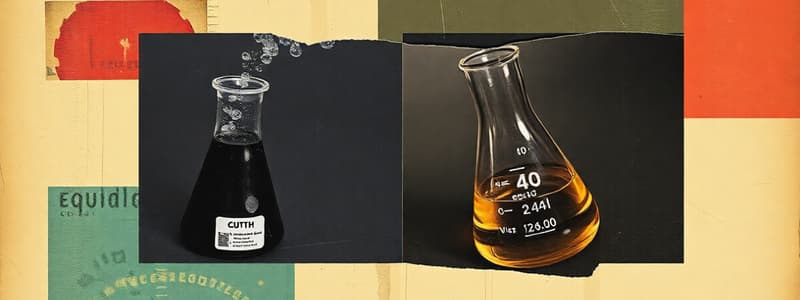Podcast
Questions and Answers
Which statement correctly describes the concept of dynamic equilibrium in a chemical reaction?
Which statement correctly describes the concept of dynamic equilibrium in a chemical reaction?
- The concentrations of reactants and products fluctuate significantly over time.
- A catalyst is necessary for reaching equilibrium.
- The reaction only proceeds in one direction.
- The rates of the forward and backward reactions are equal, resulting in constant concentrations. (correct)
What happens to the position of equilibrium when pressure is increased in a reaction?
What happens to the position of equilibrium when pressure is increased in a reaction?
- It shifts to the side with the least number of molecules. (correct)
- It remains unchanged as pressure does not affect equilibrium.
- It always shifts to the left, regardless of the number of molecules.
- It shifts toward the side with the greater number of gas molecules.
How does increasing temperature affect the position of equilibrium in an endothermic reaction?
How does increasing temperature affect the position of equilibrium in an endothermic reaction?
- It shifts the equilibrium toward the products. (correct)
- It shifts the equilibrium equally in both directions.
- It has no effect on the position of equilibrium.
- It shifts the equilibrium toward the reactants.
Which of the following is a consequence of completing a reversible reaction?
Which of the following is a consequence of completing a reversible reaction?
Which statement correctly distinguishes between the rate and position of equilibrium?
Which statement correctly distinguishes between the rate and position of equilibrium?
Flashcards
Reversible Reaction
Reversible Reaction
A reaction that can proceed in both the forward and reverse directions, reaching a state where the rates of the forward and reverse reactions are equal, resulting in constant reactant and product concentrations.
Dynamic Equilibrium
Dynamic Equilibrium
A state in a closed system where the rates of the forward and reverse reactions are equal, leading to constant concentrations of reactants and products.
Catalyst
Catalyst
A substance that speeds up the rate of a reaction without being consumed in the process. It has no effect on the position of equilibrium.
Le Chatelier's Principle
Le Chatelier's Principle
Signup and view all the flashcards
Temperature Effect on Equilibrium
Temperature Effect on Equilibrium
Signup and view all the flashcards
Study Notes
Equilibrium in Reversible Reactions
- Reversible reactions can reach dynamic equilibrium in a sealed container
- Forward and backward reactions occur at the same rate
- Reactant and product concentrations remain constant
Factors Affecting Equilibrium
-
Temperature changes:
- Increasing temperature shifts the equilibrium position towards the endothermic reaction
- Decreasing temperature shifts the equilibrium position towards the exothermic reaction
-
Pressure changes:
- Increasing pressure shifts the equilibrium position towards the side with fewer molecules
- Decreasing pressure shifts the equilibrium position towards the side with more molecules
Catalysts
- Catalysts have no effect on the position of equilibrium
- Catalysts only affect the rate of reaction, not the position of equilibrium
Studying That Suits You
Use AI to generate personalized quizzes and flashcards to suit your learning preferences.



